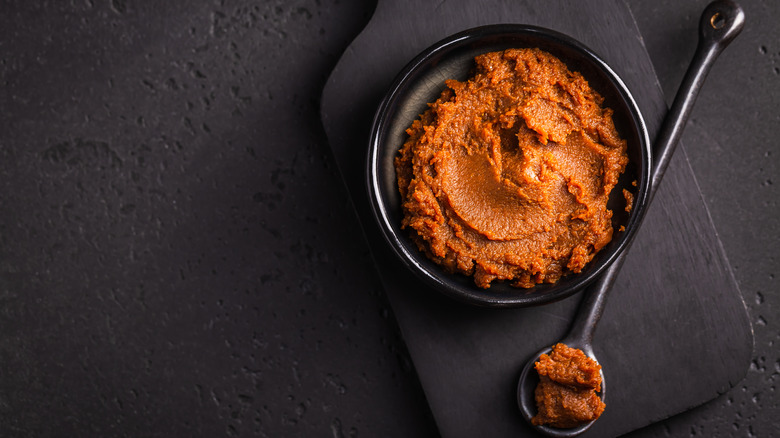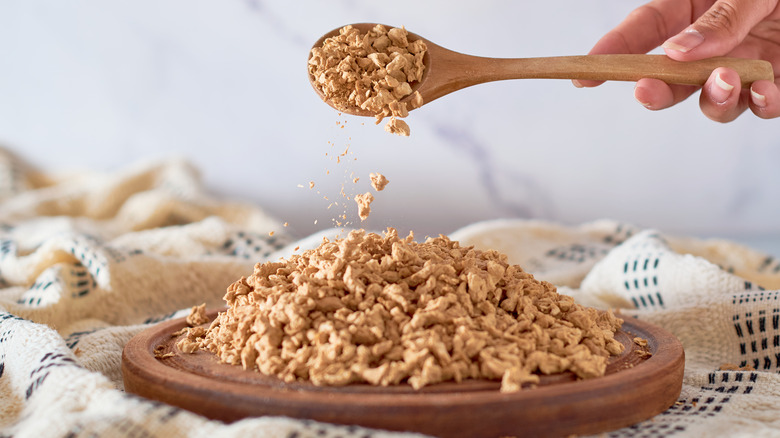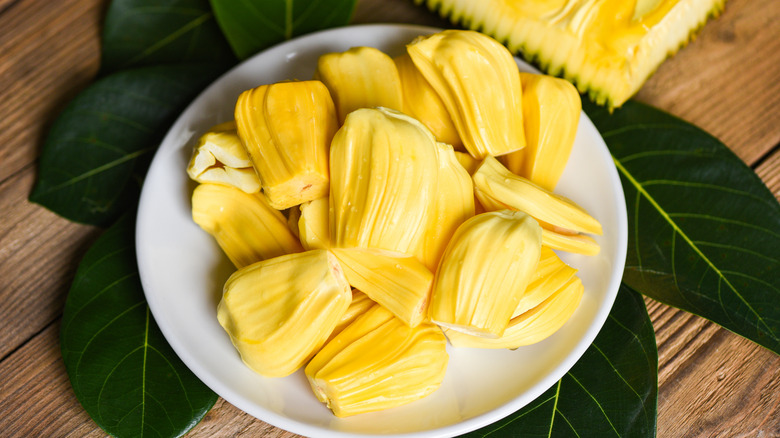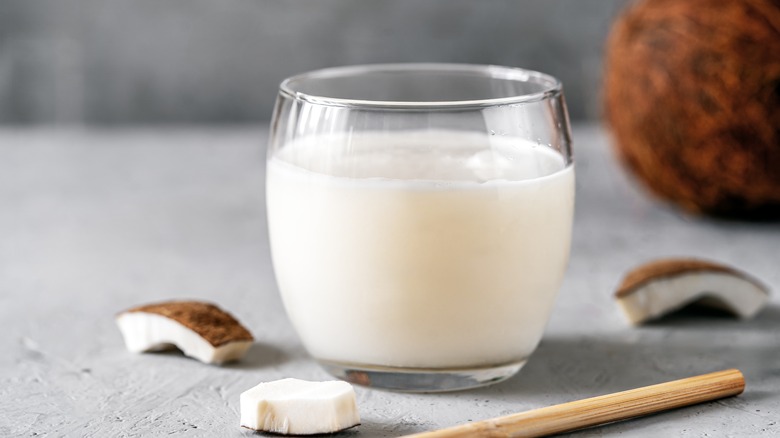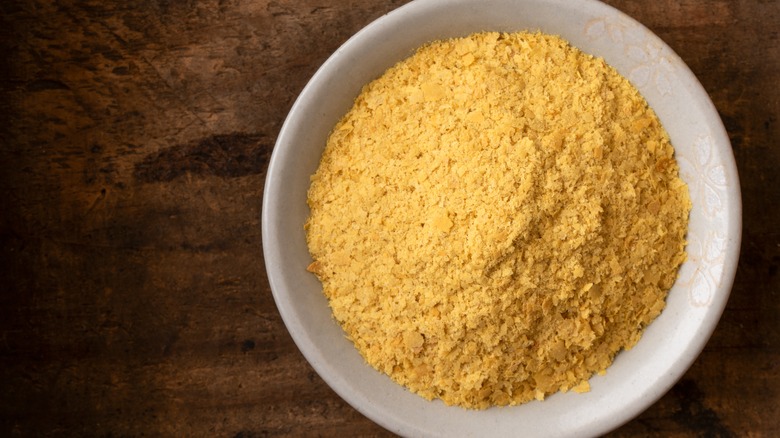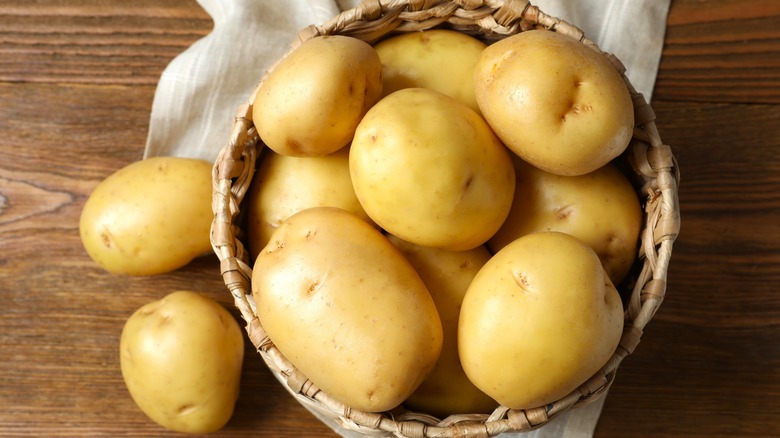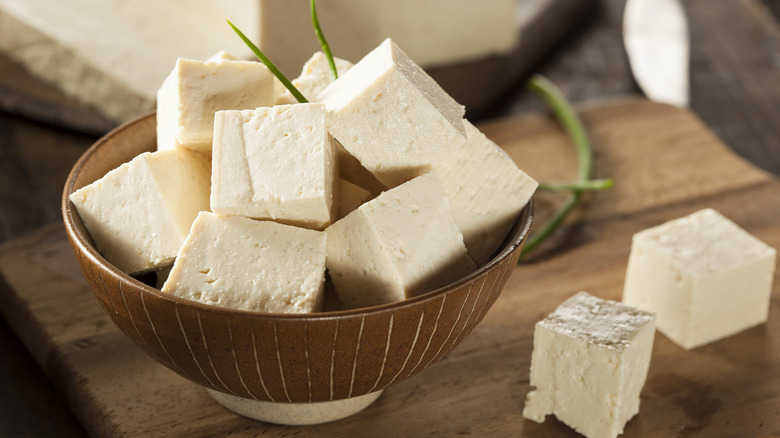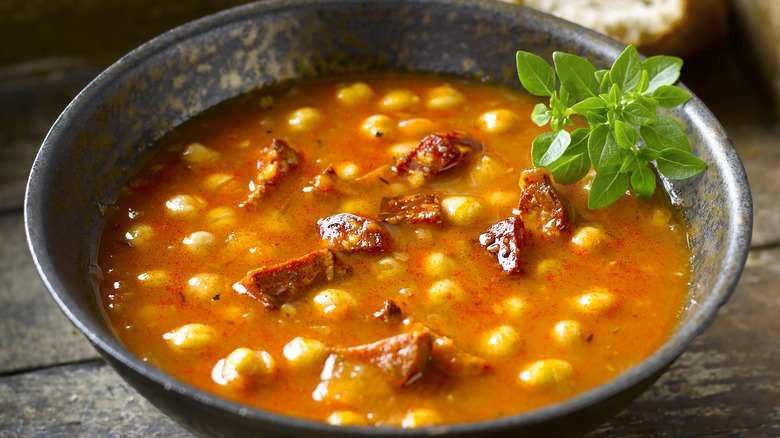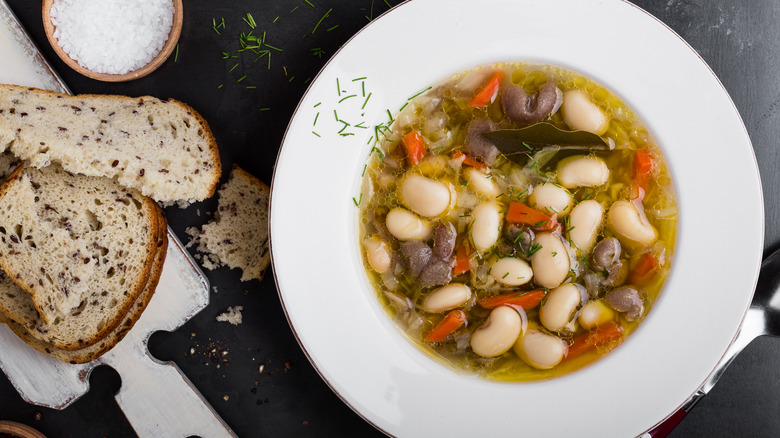13 Ingredients To Level Up Any Vegan Soup
Hark, soup enthusiasts! The glorious season of soup is upon us. The beauty of soups and stews lies not only in their ability to chase away the chill on a brisk winter day, but also in their versatility. Any combination of grains, legumes, and veggies can make a delicious soup, therefore, it's a dish that frequently graces a vegan's table. While savory stews and creamy soups usually incorporate animal products, there's always a way to veganize your favorite recipe or create a new plant-based dish from scratch.
Plant-based soups are heart-healthy, can be chock-full of protein, and are typically loaded with fiber and antioxidants when made with minimally processed foods like veggies and whole grains. I've compiled this diverse list of ingredients to add heartiness and health benefits while upgrading the flavor of your plant-based soups and stews. Despite containing no animal products whatsoever, these add-ins provide meat-like richness and creaminess that will have you ditching the dairy for good.
So, whether you've been vegan for years, are eager to diversify your soup selection, or are getting a head start on New Year's health goals, this ingredient list will take your plant-based soups to the next level. Use it to upgrade classic recipes or create your own veggie-packed winter warmer and watch the soupy possibilities unfold before your eyes.
Up the umami with miso
Miso is ubiquitous in Japanese cuisine, especially when it comes to soup. At first glance, you might not guess what this unassuming ingredient is or what it could be used for, but its humble appearance unlocks eons of flavor possibilities. Miso is a paste made from fermented soybeans, grains, and koji, a fungus that sprouts from fermented grains. Its texture is akin to peanut butter, and it's ready to use right out of the container; just grab a scoop and mix it in.
Miso paste is used in a variety of recipes as an addition to soup stock, marinades, and even cocktails. Miso imparts a salty, savory flavor, adding depth and accentuating other bold ingredients in a dish. Umami-packed miso pairs well with nearly any soup, so add a dollop to vegetable stock or make a soup base with miso alone and watch veggies come to life. Add pleasantly funky miso to caramelized sweet potato soup for a naturally sweet, salty, and deeply savory dish. Or, make a traditional miso soup — a Japanese classic that's vegan by nature — with tofu, mushrooms, and greens.
Make a hearty stew or chili with TVP (textured vegetable protein)
When it comes to textured vegetable protein — more commonly known as TVP — the possibilities know no bounds. This versatile, vegetarian ingredient is typically made from the byproduct produced when soybean oil is made. It has an ideal texture to mimic ground beef, so instead of tossing the byproduct in the trash, it's repurposed to act as a healthy, vegan meat alternative. Once the oil is extracted from the soybeans, the dry, paste-like substance that's left over is then dehydrated to make TVP, like this one from Bob's Red Mill.
TVP looks similar to ground meat and has a very mild, neutral flavor. To make TVP as beef-like as possible for use in chili, beef stew, or any other meat-laden soup or stew recipe, you only need to add a few pantry staples. Douse the TVP in a mixture of soy sauce, vegetable or vegan beef broth, liquid smoke, garlic powder, and paprika. Pan-fry the mixture to give it a slightly crispy texture, and then add your bean-based beef to soup or stew and savor the heartiness.
Jackfruit mimics tender meat
Jackfruit has joined the ranks of vegan meat alternatives in recent years, cementing itself as one of the most popular faux meats alongside staples like tofu and TVP. Jackfruit is a tree fruit grown in tropical climates all over the world. The large, amorphous fruit is harvested before it is fully ripe — when its flavor is mild and its texture is tender but solid — and then typically canned or bagged. Large chunks are then pulled apart with a fork or by hand to reveal strips of tender and neutral-tasting fruit that are similar in texture and consistency to pulled pork (and often used to make vegan BBQ dishes).
Jackfruit can replace meat in nearly any soup recipe, but it makes a particularly good substitute for chicken. Make a classic chicken noodle soup with jackfruit, or try a flavorful jackfruit tortilla soup loaded with Mexican spices. Use plant-based milk to make a vegan-style creamy chicken and rice soup with jackfruit; this dish is delicious no matter what veggies you toss in or herbs and spices you use to season it. Opt for canned jackfruit, like this Native Forest organic young jackfruit, over bagged for optimal taste and texture. Canned jackfruit is typically packed in brine, ensuring that the fruit doesn't dry out or lose its mildly sweet flavor.
Make ultra-creamy soups with coconut milk
Whether you eat a plant-based diet or not, once you start making soups with coconut milk, you'll never want to go back to regular milk or cream again. Although coconut milk is typically associated with Southeast Asian and Indian cuisine, it can replace dairy milk in just about any recipe. It's ultra decadent, with just a few tablespoons having the ability to take a soup from thin and brothy to rich and creamy, while imparting only a slightly sweet coconut flavor. Like dairy milk, coconut milk's high fat content is to thank for its velvety smooth texture and taste.
While coconut milk is delicious as a dairy alternative in nearly every soup recipe, it pairs particularly well with salty-sweet soups or recipes that can benefit from the hint of tropical flavor. Coconut milk and pumpkin come together to create a sweet and earthy soup, where coconut milk's creaminess accentuates pumpkin's nuttiness. Coconut milk also pairs well with Asian spices and ingredients, especially curry. Try a curried pumpkin soup where coconut milk complements the taste of curry and everyone's favorite fall veggie. This well-rounded dish has earthy, spicy, and sweet flavors all rolled into one warming comfort meal.
Add texture and cheesy flavor with nutritional yeast
Despite the incredibly unappetizing moniker, nutritional yeast — better known as "nooch" in the vegan community — provides a way to instantly add a cheese-like, nutty flavor to any dish. Nutritional yeast is similar to the yeast used to make homemade bread, with the main difference being that nooch is an inactive yeast. It's chock full of B vitamins, including vitamin B12 — something vegans tend to lack — protein, and fiber. It's ready to use right from the container and lasts for about two years if stored properly, so grab some nooch and get to sprinkling.
Umami-loaded, cheesy nooch like this one from Bragg adds flavor and health benefits to vegan soups that could use some added nutrients and savoriness. Make a vegan broccoli and "cheese" soup by mixing veggie stock, nooch, and creamy coconut milk into a broccoli-laden base. Or sprinkle some into a standard vegetable soup to up the savoriness. The flavor of nooch is ideal for a creamy roasted garlic soup, where its Parmesan-like taste complements garlic while toning down its aggressive pungence.
Potatoes are a healthy, vegan alternative to cream
Potatoes may be the most versatile ingredient known to man, and I'm about to add yet another use to the spud's repertoire. Soups don't need to be crafted with dairy or plant milk to be rich and delicious; potatoes act as a healthy alternative to fatty milks in creamy soups. Potatoes are low in fat and brimming with vitamin C and potassium. Their flavor is neutral, so they can be blended into most soup recipes undetected.
To make soups extra luxurious, simply blend one large, cooked potato (or more, depending on the size of the recipe) with vegetable stock. Add the blended concoction to your soup, and voila! Your soup is nearly as creamy as one loaded with high-fat milk. Use this trick in broccoli soup with nooch for a luscious, cheese-like flavor and texture, or simply make a creamy potato soup with blended spuds instead of milk. Blended potatoes are a great addition to a standard vegetable soup, taking it from thin and watery to thick and indulgent.
Soy sauce or tamari make a beef-like broth
It's not uncommon for vegan soups to lack depth and come across as bland. But a dash of soy sauce or tamari can boost savory flavor and add a meat-like taste to soups that's usually only attainable when cooking with beef broth. Soy sauce has been around for thousands of years, and although this salty, umami-packed condiment hails from Japan, it's a prominent feature in home kitchens and on restaurant tables all over the world. Soy sauce is made from — you guessed it — soybeans (a ubiquitous ingredient for vegans) as well as wheat, salt, and yeast. Its salty and slightly bitter flavor adds depth to soups, meshing well with vegetable stock without overpowering its natural sweetness.
Tamari — a cousin of soy sauce, if you will — is made from koji, an ingredient in miso. Tamari is typically less salty than soy sauce and has an even more umami-forward taste thanks to the unique flavor of koji. While both ingredients can often be used interchangeably, taste preference and health factors may play a role in determining which one to toss in a soup. If you want to give your plant-based soup or stew a leg up in the umami department but are wary of your salt intake, tamari might be the ideal choice for your recipe. If your soup could use savoriness and a salty punch, soy sauce is the way to go.
Mushrooms are an earthy, whole-food meat substitute
Whether you're aiming to make plant-based imitation meat, or you just want to bulk up a recipe, mushrooms are a great addition to vegan soups, stews, and chili. Their earthiness adds a robust, savory flavor, but they remain mild enough to not overpower your dish. Mushrooms are naturally high in fiber and antioxidants, and studies show they can boost brain function and support heart health, adding extra nutritional benefits in soup alongside vitamin-rich vegetables.
To turn mushrooms into a meat substitute, toss them in a food processor (be sure to leave them raw) and pulse them until they're crumbled. Then, cook the shroom bits in a skillet until slightly brown, and add soy sauce, paprika, and liquid smoke before mixing it into a soup, stew, or chili. Mild-tasting portobello mushrooms are ideal for this purpose when you want mushrooms to add texture but not alter taste. However, if you want a fungus with flavor, try porcini or shiitake mushrooms. These fruits of the forest pack a punch of umami and add earthiness that works wonders in creamy dishes, like mushroom and wild rice soup made with coconut milk.
Tofu or tempeh is a game-changer for vegan chicken noodle soup
It's the perfect soup for when you're sick, it's universally loved by both kids and adults, and it can easily be made plant-based: it's chicken noodle soup. To turn this classic vegan, soybeans make yet another appearance on this list in the form of tofu or tempeh. Both plant-based staples have Asian origins and are made from soybeans, but tofu is made from coagulating soy milk, while tempeh comes from fermented soybeans. Tofu has an incredibly neutral taste, but it holds onto flavor well when marinated or coated with seasonings. Tempeh, on the other hand, has a nuttier, more savory profile and a firmer texture. Both meat alternatives make great substitutes for chicken, and choosing which one to use in your soup depends entirely on preference.
To use tofu as a chicken substitute in chicken noodle soup (or in any recipe that calls for chicken) choose extra-firm tofu and press the liquid from the block, then bake your tofu in strips. Once it's been baked and is firm and crispy, cut the tofu to your preferred size and add it to the soup. To use tempeh in your soup, cut the tempeh and cook it in a skillet or directly in the stock pot. Once it's golden brown, add the remaining soup ingredients. To ensure your faux-chicken noodle retains its classic flavor, try using a commercial vegan chicken broth like Better Than Bullion No-Chicken Base, designed to be identical to the real thing.
Make rich, meaty soups with vegan sausage
While using whole-food, all-natural meat alternatives is a great way to add savoriness and texture akin to meat, nothing beats the uncanny flavor of commercial plant-based meats. The commercial vegan meats of yesteryear were known to be lackluster in both taste and texture, but today, companies like Beyond Meat and Impossible Foods create meat substitutes that allow vegans to recreate their old meat-heavy favorites. Of these popular commercial vegan meats, sausage is among the best for soups.
Swap out pork sausage with vegan sausage in any recipe that calls for it, like a chunky kale and white bean soup with herby Italian sausage. Or, add sausage to a veggie-based soup or stew for added luxurious, meaty flavor and heartiness. Vegan sausage tends to crumble more easily than traditional sausage, so instead of being disappointed when the sausage chunks disintegrate in your soup, let it work to your advantage. Make a creamy, garlicky soup with crumbled sweet and spicy plant-based Italian sausage, coconut milk, and fresh herbs of your choosing. Or, try a dinner-worthy soup made with vegan chorizo crumbles, beans, spicy peppers, and cilantro.
Accentuate savory ingredients and add a touch of sweetness with ginger
Ginger has the potential to be finicky; it's not as versatile as other ingredients on this list, but when used in the right soup, it adds the perfect touch of sweetness, a hint of spice, and brings out the flavor in savory veggies. With antioxidants and stomach-soothing abilities, gingery soup is ideal for when you're feeling under the weather. You can add ginger powder to soups and stews in a pinch, but fresh ginger always provides optimal flavor.
Ginger's zesty taste pairs beautifully with citrus and bright, sweet veggies like carrots and beets. Make a spicy carrot ginger soup by blending cooked carrots and fresh ginger with vegetable stock and coconut or oat milk. Add a touch of maple syrup and garnish with roasted pumpkin seeds to make this soup fit for fall. Or, grate fresh ginger into an herby vegetable soup to add a sweet and tangy kick. If you're feeling sick, whip up a plant-based chicken noodle soup with plenty of ginger to aid your recovery (and because it tastes delicious).
Blended nuts give soup a creamy texture with healthy fats to boot
If you're on the hunt for an inventive, unconventional way to up the creamy factor in soups, look no further than the long-forgotten bag of nuts tucked away in your pantry. You don't need to make nuts the star of the soup; they're best used to add body and richness to a recipe. While tossing whole nuts into soup isn't the best idea, if you're willing to put in a little legwork, blended nuts make an excellent soup companion. If your recipe yields a thin soup that's less than filling, nuts add healthy, plant-based fats and extra calories for a heartier bowl.
Opt for cashews to make your soup base smooth and silky; their mild taste and soft texture make them easy to blend and let them act as a blank canvas for you to season with whatever herbs and spices you prefer. Walnuts and peanuts also work well, although peanuts will likely impart a stronger nutty flavor. Let your nuts sit in boiling water for about 30 minutes, and then transfer them to a blender or food processor. Blend until they're smooth, adding water as necessary to reach your desired consistency. Slowly mix the blended nuts into your soup, and watch as your broth becomes thick and velvety. Use this method to create a vegan carrot and cashew soup, where the flavor of nuts is a feature alongside sweet carrots, tangy lemon, and herbaceous spices.
Beans bulk up soups to make them meal-worthy
There's not a vegan on Earth who doesn't relish every opportunity to cook with beans. Not only are they a necessary part of a meat-free diet, but they go with nearly any dish, are super cheap, and provide loads of health benefits — what's not to love? Beans are abundant in fiber, protein, and necessary macrominerals like magnesium, potassium, and phosphorus. They're mild, dense, and creamy and can be used to swap out meat in a dish, or be the main attraction in their natural form.
Plop a can of beans into your favorite soup recipe — like vegetable and noodle or creamy mushroom — to bulk it up and stretch it further. Or, use beans in the same way you'd use cashews to make soup thick and decadent: Blend them with water and add them to a thin soup stock. If you want to experience beans in all their glory, make them the star of a recipe, like in a spicy black bean soup with carrots, garlic, bell pepper, and jalapeño pepper. When it's almost finished, pulse this soup with an immersion blender to blend some of the beans and make the broth extra rich and hearty.

